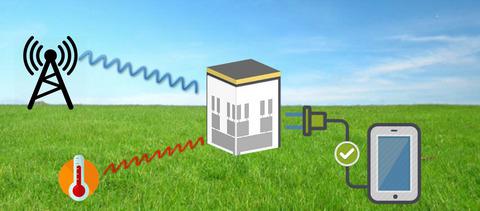当前位置:
X-MOL 学术
›
Energy Sci. Eng.
›
论文详情
Our official English website, www.x-mol.net, welcomes your feedback! (Note: you will need to create a separate account there.)
Multi‐source ambient energy harvester based on RF and thermal energy: Design, testing, and IoT application
Energy Science & Engineering ( IF 3.8 ) Pub Date : 2020-07-28 , DOI: 10.1002/ese3.784 Azamat Bakytbekov 1 , Thang Q. Nguyen 1 , Weiwei Li 1 , Anton Lee Cottrill 2 , Ge Zhang 2 , Michael S. Strano 2 , Khaled N. Salama 1 , Atif Shamim 1
Energy Science & Engineering ( IF 3.8 ) Pub Date : 2020-07-28 , DOI: 10.1002/ese3.784 Azamat Bakytbekov 1 , Thang Q. Nguyen 1 , Weiwei Li 1 , Anton Lee Cottrill 2 , Ge Zhang 2 , Michael S. Strano 2 , Khaled N. Salama 1 , Atif Shamim 1
Affiliation

|
Billions of wireless sensing devices must be powered for IoT applications. Collecting energy from the ambient environment to power sensor nodes is a promising solution. Solar energy has been one of the main sources of ambient energy due to its availability, higher power density, and the maturity of the solar photovoltaic industry. However, there are many scenarios (indoor environment, outdoor environment during nighttime, poor weather conditions, underground, etc) where ambient solar energy is either not available or not sufficient for practical applications. For such scenarios, other renewable sources of energy must be sought. Typically, not enough power is collected from one ambient source to charge sensor nodes for continuous operation. In this work, we present a multi‐source energy harvester that collects RF and thermal energy (both available 24 hours) from the ambient environment simultaneously. The RF energy harvester is multi‐band and collects power from GSM (900, 1800 MHz) and 3G (2100 MHz). The thermal harvester converts diurnal temperature fluctuations to electrical energy using high thermal effusivity phase change material. Extensive field testing has been performed in three different conditions—outdoors, indoors, and buried underground—to highlight the usefulness of the multi‐source energy harvester in all these environments. When one source is disabled, the harvester still generates energy from the remaining active source and can enable continuous operation of futuristic IoT sensors. As a proof of concept, a real‐world IoT application is demonstrated, where temperature and humidity sensors are powered by the multi‐source energy harvester. Continuous robust operation of the sensors and wireless data transmission after each 3.7 seconds are expected when both harvesters operate in full mode. Scenarios, where only single thermal energy harvester or only single RF energy harvester operates, are also demonstrated and data transmission with average time intervals of 30 seconds and 9 minutes is achieved, respectively.
中文翻译:

基于射频和热能的多源环境能量收集器:设计,测试和物联网应用
数以十亿计的无线传感设备必须为物联网应用供电。从周围环境收集能量到功率传感器节点是一种很有前途的解决方案。太阳能由于其可用性,更高的功率密度以及太阳能光伏产业的成熟而已成为环境能源的主要来源之一。但是,在很多情况下(室内环境,夜间室外环境,恶劣的天气条件,地下环境等),周围的太阳能要么不可用,要么不足以用于实际应用。对于这种情况,必须寻求其他可再生能源。通常,从一个环境源收集的功率不足,无法为传感器节点充电以进行连续操作。在这项工作中 我们提供了一种多源能量收集器,它可以同时从周围环境收集射频和热能(均可在24小时内使用)。RF能量收集器是多频段的,可收集GSM(900,1800 MHz)和3G(2100 MHz)的功率。热收集器使用高热发射率相变材料将昼夜温度波动转换为电能。在三个不同的条件下(室外,室内和地下埋藏状态)进行了广泛的现场测试,以突出多源能量收集器在所有这些环境中的有用性。当禁用一个源时,收割机仍会从剩余的活动源中产生能量,并可以使未来派物联网传感器连续运行。作为概念验证,演示了一个真实的物联网应用程序,温度和湿度传感器由多源能量采集器供电。当两个收割机都以全模式运行时,预计传感器将持续稳定运行并在每3.7秒后进行无线数据传输。还演示了仅运行单个热能收集器或仅运行单个RF能量收集器的场景,并且分别实现了平均时间间隔为30秒和9分钟的数据传输。
更新日期:2020-07-28
中文翻译:

基于射频和热能的多源环境能量收集器:设计,测试和物联网应用
数以十亿计的无线传感设备必须为物联网应用供电。从周围环境收集能量到功率传感器节点是一种很有前途的解决方案。太阳能由于其可用性,更高的功率密度以及太阳能光伏产业的成熟而已成为环境能源的主要来源之一。但是,在很多情况下(室内环境,夜间室外环境,恶劣的天气条件,地下环境等),周围的太阳能要么不可用,要么不足以用于实际应用。对于这种情况,必须寻求其他可再生能源。通常,从一个环境源收集的功率不足,无法为传感器节点充电以进行连续操作。在这项工作中 我们提供了一种多源能量收集器,它可以同时从周围环境收集射频和热能(均可在24小时内使用)。RF能量收集器是多频段的,可收集GSM(900,1800 MHz)和3G(2100 MHz)的功率。热收集器使用高热发射率相变材料将昼夜温度波动转换为电能。在三个不同的条件下(室外,室内和地下埋藏状态)进行了广泛的现场测试,以突出多源能量收集器在所有这些环境中的有用性。当禁用一个源时,收割机仍会从剩余的活动源中产生能量,并可以使未来派物联网传感器连续运行。作为概念验证,演示了一个真实的物联网应用程序,温度和湿度传感器由多源能量采集器供电。当两个收割机都以全模式运行时,预计传感器将持续稳定运行并在每3.7秒后进行无线数据传输。还演示了仅运行单个热能收集器或仅运行单个RF能量收集器的场景,并且分别实现了平均时间间隔为30秒和9分钟的数据传输。


























 京公网安备 11010802027423号
京公网安备 11010802027423号